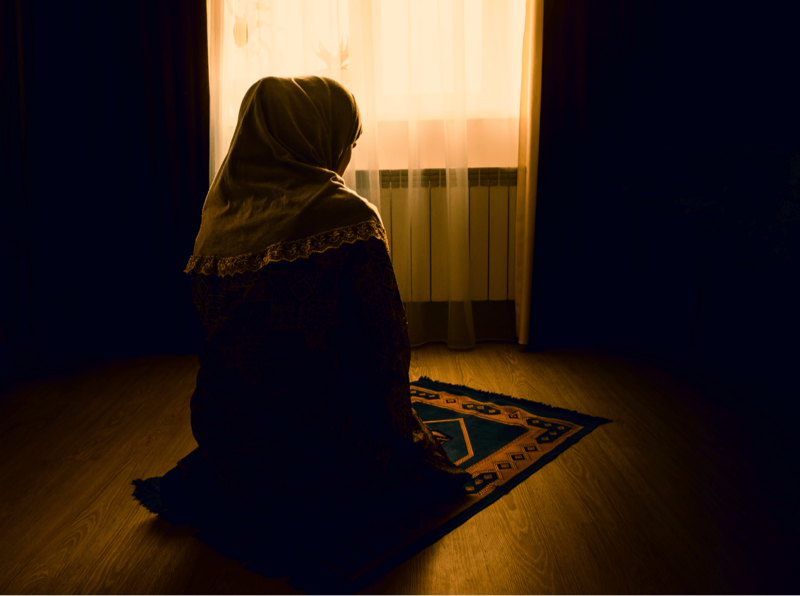
Sujood Sahw refers to the prostrations of forgetfulness. There are instances in our Salat/Prayer when we commit some errors or forget to do something (which is supposedly a part of Salat/Prayer); such cases are dealt with Two Sujood Sahw (prostrations of forgetfulness).
Let us find out the correct way of dealing with such cases, according to Sunnah.
1. If we forget any part of Rakaat or a whole Rakaat during Prayer/Salat:
Narrated by Abdullah bin Buhaina Al-Asdi (RA):
“Allah’s Messenger (S.A.W.) stood up for the Zuhr prayer and he should have sat (after the second rak`a but he stood up for the third rak`a without sitting for Tashah-hud) and when he finished the prayer he performed two prostrations and said Takbir on each prostration while sitting, before ending (the prayer) with Taslim; and the people too performed the two prostrations with him instead of the sitting he forgot.” (Sahih Bukhari: 1230)
This hadith tells us that if we forget to pray At-Tahhiyat in second Rakaat of any prayer consisting of more than two Rakaat (i.e. Zuhr, Asr, Maghrib or Isha), we should do Sujood Sahw in last Rakaat before finishing the prayer with Taslim.
On similar lines, if someone forgets a whole Rakaat or more than a Rakaat, then again Sujood Sahw has to be performed. Refer to following hadith:
Abu Hurairah (R.A.) reported; The Prophet (S.A.W.) offered the noon prayer and he gave the salutation at the end of two rakahs. He was asked. Has the prayer been shortened? then he offered two rakahs of the prayer and made two prostrations (at the end of it). (Abu Dawud: 1014)
NOTE: In other similar narrations it is mentioned that he performed prostrations after Taslim.
- If we pray additional Rakaat in Salat:
Narrated Abdullah (RA):
Once Allah’s Messenger (S.A.W.) offered five rak`at in the Zuhr prayer, and somebody asked him whether there was some increase in the prayer. Allah’s Messenger (S.A.W.) said, “What is that?” He said, “You have offered five rak`at.” So Allah’s Messenger (S.A.W.) performed two prostrations of Sahu after Taslim. (Sahih Bukhari: 1226)
This narration tells us that the Prophet (S.A.W.) performed Sujood Sahw in this case after Taslim. The reason is simple, by the time he came to know that he has prayed additional Rakaat, he had completed his prayer. So he performed Sujood Sahw as soon as he came to know about his forgetfulness.
- What to do when in doubt about how many Rakaat we have prayed while in Salat?
Forgetfulness is a normal thing which can happen with any human being. Shaitan/Satan/Devil leaves no stone unturned to keep our attentions diverted and distracted from good deeds. This is also one of those efforts of Devil/Shaitan and a Muslim is supposed to be well versed with the technique of combating these tactics of Devil/Shaitan.
If during a prayer any of us forgets which number of Rakaat is he/she is praying (or how many Rakaat he/she has completed by that time), then he/she is supposed to act according to following advice from our beloved Prophet (S.A.W.):
It was narrated from Abu Saeed Al-Khudri (R.A.) that:
‘The Prophet (S.A.W.) said: “If one of you does not know whether he prayed three or four (rak’ahs), let him pray a rak’ah then prostrate twice after that when he is sitting. Then if he prayed five (rak’ahs), they (the two prostrations) will make his prayer even-numbered, and if he had prayed four, they will annoy and humiliate the shaitan.”’ (An-Nasai: 1239)
Therefore, in case of doubt, one should act upon whatever is certain. For example, if one is not sure how many Rakaat he/she has performed, two or three and four or five, he/she should take the lesser number as the basis. Based on the number, he/she should proceed to perform the remaining Rakaat and complete the prayer by performing two prostrations (of Sahw).
4. Sujood Sahw is to be done before Taslim or after Taslim?
After going through all the narrations mentioned above, we come across two scenarios: in one case we come to know that Messenger of Allah (S.A.W.) performed two prostrations before Taslim, while in other case he performed two prostrations after Taslim. Although, I see no point of confusion, still different views prevail about whether one should perform Sujood Sahw before or after Taslim?
Imam Shafi’s view is that the prostrations should be performed before Taslim. However, this view cannot be made universal as there are narrations which prove that the Prophet (S.A.W.) performed it after Taslim as well.
According to Imam Ahmad, whatever is reported from the Prophet (S.A.W.) about the prostrations for As-Sahw, is to be acted upon. It can be before Taslim or after Taslim, depending upon the cases as done by our beloved Prophet (S.A.W.). In cases where it is reported that the Prophet (S.A.W.) performed Sujood Sahw before Taslim, we should follow that way. For cases where it is reported that the Prophet (S.A.W.) performed Sujood Sahw after Taslim, we have to follow that way. In cases where nothing is reported about, then two prostrations should be followed before Taslim.
5. Sujood Sahw is accompanied by Takbir:
If we revert back to the Hadith mentioned in Section 1, we see that there is mention of Takbir (saying Allah-o-Akbar). Therefore, Takbir is to be said before performing Sujood Sahw.
6. Tashahhud is not recited after performing Sujood Sahw:
Narrated Salama bin Alqama (R.A.):
‘I asked Muhammad (bin Seereen) whether Tashah-hud should be recited after the two prostrations of Sahu. He replied, “It is not (mentioned) in Abu Huraira’s narration.”’ (Sahih Bukhari: 1228)
7. Sujood Sahw should be performed for Nawafil prayers also.
Imam Al-Bukhari has said in his Sahih Bukhari “Bab al-Sahw fi’l-fard wa’l-tatawwu’ [Chapter on forgetfulness in obligatory and voluntary (prayers)]. Ibn Abbas (R.A.) did two prostrations after Witr, and al-Haafiz said in al-Fath, commenting on the report of Ibn Abbas: this was narrated by Ibn Abi Shaybah with a saheeh isnaad.
In the light is above mentioned Hadith, it is clear that Sujood Sahw should be performed if we commit an error during Nawafil prayers too.
8. How many prostrations are to be performed for forgetfulness?
No. of prostrations for forgetfulness are two. Some schools of thoughts state that only one prostration is done for forgetfulness. However, almost all the narrations regarding the Prophet’s (S.A.W.) action in this context refers to two prostrations (refer to all narrations mentioned in this discussion). Hence, two prostrations are to be performed.
9. It is wrong to say that Sujood Sahw cannot be performed if the person has talked after Salat.
Some schools of thoughts are of the view that Sujood Sahw can be performed only till we have not talked after Salat. This is not correct, as several of the narrations mentioned above (in Section 1 & Section 2) tell us that Rasool-Allah (S.A.W.) was reminded by others of his forgetfulness after he had completed his Salat and he talked to the persons who reminded him, confirmed his forgetfulness and then performed Sujood Sahw. Therefore, one is allowed to perform prostrations of forgetfulness even if he/she has talked after Salat.
Concluding remarks
To err is human. Therefore, it is natural that one may make mistakes; it can happen during Salat too. However, as discussed above, a Muslim should be well versed about how to amend his/her mistake during a prayer so as not to let the prayer be affected. We have discussed the actions of our beloved Prophet (S.A.W.) which all of are supposed to follow.
Remember, Sujood Sahw compensates for minor mistakes / errors / forgetfulness, like those mentioned in different narrations above. Bigger mistakes (like not reciting Surah Fatiha, or starting pray without Ablution (Wudu) etc.) should not be (or rather cannot be) compensated by Sujood Sahw.
Also, more than one error during a prayer does not require additional prostrations. One set of prostrations for forgetfulness is enough.
So, next time, when anyone of us commit any mistake (among those mentioned above), then he/she should not worry. Rather remember the procedure(s) for Sujood Sahw for each case and be assured.
And Allah knows best.
May Allah forgive me if I am wrong and guide us to the right path…Ameen.
1. Addition
Of the Same Kind As Found In Salaah
Causes of | If One Remembers | What To Do | Do Sujood |
1. a- Additions in actions | – During the addition | – Stop doing this addition | After Tasleem |
– Soon after Tasleem | – Must do Sujood al-Sahw | After Tasleem | |
– After long time | – Salaah/Prayer is invalid | ||
Another example | – During the addition | – Stop doing this addition | After Tasleem |
– Soon after this Tasleem | – Go back to sitting position | After Tasleem | |
– After long time | – Salah/Prayer is invalid | ||
1. b – additions in sayings | – Soon after tasleem | – Sunnah to do Sujood al-Sahw | After Tasleem |
– After long time | – Nothing upon him |
2. Omissions in Salaah/Prayer [Rukn (pillar), Wajib (obligation) and Sunnah]
Causes of | If One Remembers | What To Do | Do Sujood |
2. a – Omissions of Rukn (pillar) | – Before reaching the place of the missing Rukn in the next Rakat | – Return and do this missing Rukn | After Tasleem |
– After reaching the place of the missing Rukn in the next Rakat | Rakat with missed Rukn is cancelled and present Rakat replaces it – Must do Sujood al-Sahw | After Tasleem | |
– After Tasleem | – Return and do this missing Rukn | After Tasleem | |
– After Tasleem | – Do a complete Rakat and Tasleem | After Tasleem | |
– After a long time | – Salaah/Prayer is invalid | . | |
2. b – Omissions of | – When having determination to move but did not move yet | – Return to do missing obligation | No |
– When starting to move but did not finish to stand fully yet | – Return to do missing obligation | After Tasleem | |
– After finishing to stand up correctly | – Return is forbidden | Before Tasleem | |
2. c- Omissions in Sunnah | – Before the Tasleem | – Recommended only if this omitted Sunnah is a usual habit of this person | Before Tasleem |
Rukn and Wajib (Pillar and Obligation) | |||
3. Doubt (Ash Shakk) wavering between two matters such that none has distinction over the other
Causes of Sujood al-Sahw | If One Remembers | What To Do | Do Sujood |
3. Doubt (Ash-Shakk) | – During Salaah/Prayer. | Build up on certainty, i.e. the least, | Before Tasleem |
| – During Salat/Prayer and | build up on the preponderation this is the 3rd Rakat | After Tasleem |
– During Salaah/Prayer and | Build up on the preponderation this is the 4th Rakat | After Tasleem | |
Doubt is not to be considered in three situations -> | |||
4. Different Situations (1. Droping of Sujood Al-Sahw, 2. Repetition of Forgetfulness and 3. other cases where there is no Sujood al-Sahw)
Situations | Cases | What To Do | Do Sujood |
a. Droping of Sujood al-Sahw | 1. If he remembers long time after Tasleem | ||
2. If he nullifies his Wudhu after Salaah/Prayer | |||
3. If he begins doing another Salaah/Prayer | time is long -> – obligation drops | No | |
time is short -> | Either before or after Tasleem in the 1st Salat | ||
4. if he leaves the mosque | a – obligation drops | No | |
b – obligation remains | See footnotes | ||
b. Repetition of forgetfulness in the same Salat/Prayer | – in the same Salah, there are many mistakes requiring Sujood al-Sahw | – Preponderating opinion -> | Either before or |
– a mistake requiring Sujood al-Sahw before Tasleem and | – first opinion -> | Before Tasleem (3) | |
– a strong opinion -> | Before and also | ||
Sujood al-Sahw is NOT applicable in the following situations -> | |||
5. Ma-muum (follower of Imam from Beginning of Salah), Masbuuq (one joining late), Imaam and other situations
Situations | What To Do | Do Sujood |
1. a – The Ma-muum | – He follows the Imaam | Follows Imaam |
1. b- the Ma-muum | – Imaam bears this for him | — |
2. a- The Masbuuq | If his own mistake is AFTER he departed from Imaam | Either after or before his own Tasleem |
2. b – The Masbuuq | – He follows Imaam in Sujood al-Sahw | Follows Imaam |
If he did not stand up fully before Imaam makes Sujood al-Sahw | Follows Imaam | |
if he is standing up fully before imaam makes sujuud as sahw | After his own Tasleem | |
2. c – The Masbuuq He joins Imaam late in Salat/Prayer | If he did NOT meet the Imaam in his mistake | — |
If he MET the Imaam in his mistake | After his own Tasleem | |
if he does not know if he met or not the imaam in his mistake | Sujood al-Sahw | |
2. d – The Masbuuq | Example: Imaam forgot a Rakat and he is alerted and returns | — |
2. e – The Masbuuq | If he remembers | After his own Tasleem |
He does not return to complete his Salat/Prayer | ||
3. a – The Imaam | Example: Imaam recite Al-Fatiha loud in a silent Salaah | After Tasleem |
3. b – The Imaam | If he returns, his Salaah/Prayer is valid | After Tasleem |
If he does not return | ||
3. c – The Imaam | It is forbidden for him to return | Before Tasleem |
If he returns and he does not know it is forbidden | After Tasleem | |
If he returns after standing fully erect and he knows it is forbidden | ||
4. A person enters Witr Prayer with intention of doing 2 + 1 Rakat | If he forgets to say Tasleem after two Rakat | No |
5. A person makes mistake in recitation | – It does not change the format of Salah/Prayer, there is nothing upon him | No |
- One narration by Imam Ahmad saying he does the Sujood al-Sahw whether the separation was long or short.
- One opinion by Shaykh Ibn Taymiyah saying the Sujood al-Sahw continues even after a long separation.
- The Sujood al-Sahw is preferably before Tasleem because it is more part of Salaah/Prayer.
Source: http://www.missionislam.com/knowledge/prostrationforget.html
Related Posts
Showing Kindness & Dutifulness to Parents
And they [Ahl-us-Sunnah wal-Jamaa’ah] command with being kind and dutiful to one’s parents__________And this is…
Practical Guide of performing Ghusl
Practical Guide of performing Ghusl There are three classifications based on circumstances that require to…
Islam and Being a Muslim
The word “Islam” is an Arabic word that means submitting and surrendering your will to…
Practical Guide of observing Salah
Salah is an essential practice for Muslims as it serves as a direct way to…
















